A familiar moment for beginning photographers: You’ve opened up your brand new DSLR and are ready to start capturing the world around you. As you attach the lens to the camera, panic ensues: What are all those numbers and letters on the lens? What do they mean? Do I have the right lens for what I need?
Not to worry. While there are lots of numbers and letters on lenses, once you’re familiar with how to read them, it’s easy to know what lens you’re working with and what the lens will do for your photography. Rest assured, by the end of this guide you’ll be an expert on how to read camera lens numbers and choose the best lens for your next shoot.
Contents
What do camera lens numbers mean?
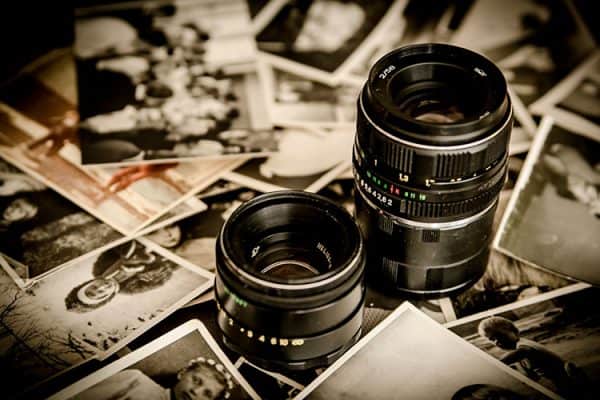
When comparing lenses, the two most important numbers are the focal length range and lens speed. Focal length range will be listed as XX-XX before the letters mm, (e.g. 18-55 mm). Lens speed or maximum aperture will be listed as some number immediately following the letter f. (e.g. f/2.8). Let’s break apart what both focal length range and maximum aperture mean for your own lenses.
What is Focal Length Range?
Every lens in your kit will have a focal length listed on the lens. Arguably, it’s the most important thing you need to know about your current lenses and it’s very important when buying new ones.
Measured in millimeters, focal length is the not the length of the lens, but how much of the scene will be in focus (angle of view) and the magnification (how large it will be relative to the original). Smaller numbers equate to shorter focal lengths and lower magnification. Larger numbers indicate a narrower angle of view and higher magnification or zoom.
Depending on the type of lens that you own, the focal length will either be listed as a range of numbers (e.g. 18-55 mm) or one number 50 mm. The difference between a focal length range and fixed focal length will indicate if your lens is a zoom lens or a prime lens.
Zoom Lenses vs. Prime/Fixed Lenses
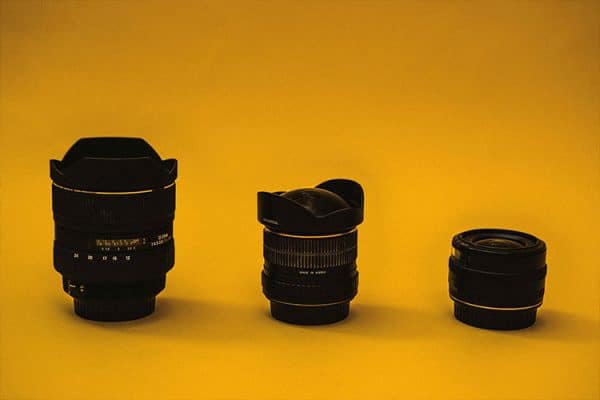
There are two types of lenses: zoom lenses and prime lenses. Zoom lenses allow you to capture a range of focal lengths using the same lens. Prime lenses—also called fixed lenses—can only capture one focal length. To determine if your lens is a zoom lens or a prime lens, simply look at the focal length numbers on the camera lens.
Zoom Lenses – For zoom lenses, you’ll see both the minimum focal length and the maximum focal length that can be captured by the lens printed directly on your lens. 18-55 mm means that the minimum distance is 18 mm and the maximum distance between the lens and the image sensor is 55 mm. Zoom lenses have great utility because they capture all the focal lengths in between the range. You can carry less camera equipment but still, have a subject in focus at any of those distances.
Zoom lenses will be printed with the range of focal lengths, but they will also have a focal length guide along part of the zoom ring. It should appear as a series of increasing numbers with a line that moves up and down as you increase or decrease the zoom. The line indicates the exact focal length you are shooting at between the minimum and maximum focal length range.
Prime Lenses – In contrast, prime lenses only have one focal length. They are sometimes called ‘fixed’ lenses because the focal length is fixed at one distance between the lens and the image sensor to keep the subject in focus. You’ll know your lens is a prime lens because the focal length will be a single number listed in front of the millimeter measurement (e.g. 50 mm or 85 mm). Prime lenses have benefits over zoom lenses because they tend to be lighter weight and also have larger maximum apertures or f/stops. They’re popular in lower light and with portrait photography.
Basic Focal Length Categories
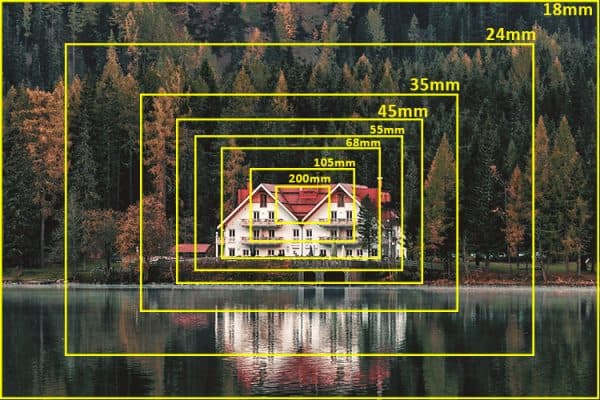
In general, these are the categories of focal lengths you’ll find among major camera brands. Below we’ll cover what each of these lens categories is used for in more detail, but this will provide a general idea of the range of focal lengths you might find stamped on your lenses:
- Ultra-Wide Angle Lenses – 10-15 mm
- Wide Angle Lenses – 16-28 mm
- Standard Lenses – 28-60 mm
- Telephoto Lenses – 60-300 mm
- Super Telephoto/Ultra Telephoto – 300mm and above
Learning More About Focal Length & Your Lenses
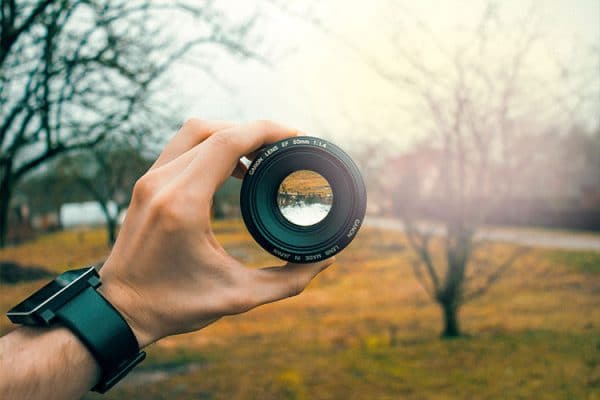
Beginning photographers should spend some time learning about the focal lengths of the lenses they own. Focal length can dramatically impact the perspective of an image and contributes to composition in ways you should be familiar with. To explore the focal length of your camera, try this exercise:
- Set up several subjects on a table at different distances across the table. Try small objects like flowers, fruit, children’s toys that are all about the same size. Place one of the items near the camera, and the others and distances on the table farther away from the camera.
- Place the camera on a tripod or at a fixed location from the objects.
- Without moving the objects or the camera, take photos with each of your lenses at different focal lengths. If you have zoom lenses, take photos at the minimum and maximum focal lengths as well as use the range guide to take a photo at each of the focal lengths stamped on the side of the lens. If possible, it’s helpful to line up your lenses least to most so that when you view the images later on the images are in order from the shortest focal length to the longest focal length you own.
- Compare the images in post-processing. In this exercise, the only thing that changes is the focal length. The distance from the objects and the perspective of the items are exactly the same. Yet as you move across the focal length ranges, you’ll see the dramatic differences in the images that appear as the camera sensor moves further from the lens.
Once you’ve done the exercise with stationary objects, move outdoors and attempt the same exercise with an object at a further distance or a landscape. It’s the best way to learn more about focal length and the lenses you own.
What is Maximum Aperture?
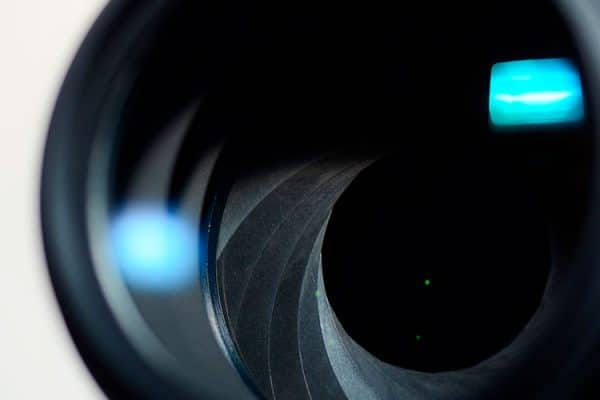
Along with focal length, you will also find maximum aperture printed on your camera lens. Aperture refers to the size of the opening where light passes through to the sensor. It’s commonly written with f/stop on the camera lens (e.g. f/5.6, f/2.8, f/2). While there’s good information online on how to interpret f-numbers (it’s actually a ratio), what’s important for beginners to know is the lower the number, the larger the aperture or size of the space where light can enter. The higher the number, the smaller the aperture or opening and the less exposure.
All lenses have a maximum aperture printed on them in the f/x.x format. This refers to the maximum size of the aperture possible with that particular lens. Prime lenses have one fixed maximum aperture. Zoom lenses can have a fixed maximum or they can have a range of maximum apertures. Fixed maximum ranges on zoom lenses tend to be more expensive, it’s more common to have an aperture range.
In the case of an aperture range, you’ll find two numbers printed on the lens. For example, you might find f/3.5-5.6 printed on the lens. In this case, depending on the focal length the zoom lens is set at, the maximum aperture will be a range from f/3.5 to f/5.6. In general, the more you zoom the narrower the aperture on the lens.
Other Camera Lens Abbreviations
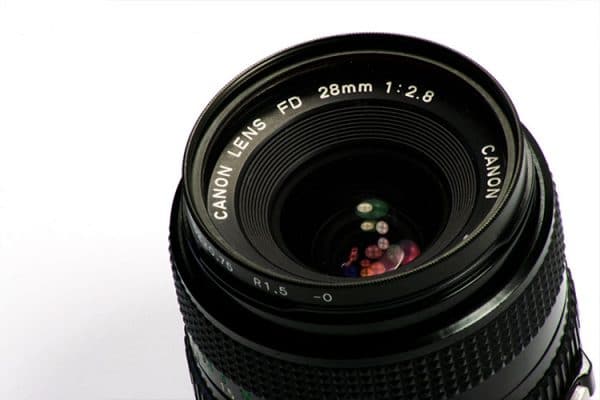
Along with focal length and maximum aperture, you may find other numbers printed on your lens. Not all lens manufacturers have these numbers and letters printed, but it helps to be familiar with the other types of abbreviations you might find on a lens.
Full Frame vs. Crop Sensor – All major camera manufacturers sell different models of cameras based on the size of the sensor. When you fit your camera lenses to your camera body, you need to make sure that the lens you purchase is compatible with the lens size (full frame vs. crop sensor vs. mirrorless. If you own a full-frame camera, you won’t be able to use a lens built for a crop sensor camera and vice-versa.
Thankfully, the manufacturers know this and each lens should be printed with a set of letters that match the same letters of your camera body to indicate compatibility. Below are the abbreviations for full-frame vs. crop sensor for the most common camera brands:
- Canon: EF (full frame) vs. EF-S (crop 1.6) vs. EF-M (crop 1.6 mirrorless cameras)
- Sigma: DG (full frame) vs. DC (crop 1.5/1.6)
- Sony: unmarked DT (crop 1.5)
- Tamron: Di Di II (crop 1.5/1.6) vs. Di III (crop 1.5/2)
- Nikon: FX DX (crop 1.5) vs. 1 Nikkor (crop 2.7 mirrorless)
Filter Size or Diameter Symbol (Ø)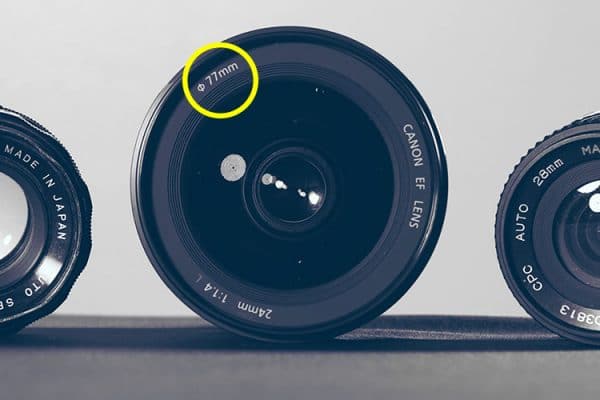
Some camera lenses have the diameter of the lens printed on it using the diameter symbol “Ø”. This refers to the diameter of the end of the lens and is helpful when purchasing filters for the camera. When you purchase filters, you’ll need to make sure that they are large enough to cover the full lens or the correct diameter for circular screw-on filters.
Lens diameter is measured in millimeters just like focal length. Ø 77 mm and Ø 82 mm are the two most common lens diameters. Be sure to have this number handy when you purchase filters online. Many filters are advertised based on the camera body, when in fact you should ensure they fit the diameter of your camera lens.
Lens Version – Some lenses will be printed with a number or letter system indicating which version of the lens you have. For example, a lens that has a “II” listed at the end of the lens name indicates that it’s the second version of that same lens model. It has the same focal length and maximum aperture as the first model but is an ‘improved’ version with higher-quality features. It’s essentially the same as how software developers use the “v2.0” terminology. You may even find “III” lenses, however third iterations of the same lens are rare.
Typically when the new lens version becomes available, the older version will no longer be available from licensed camera retailers. However, you may still be able to purchase the previous version on the used market or from an online retailer that tend to sell the older versions longer. It’s helpful to know the exact lens version you’re using though because information about older versions quickly becomes hard to find. If you’re reading reviews about lens performance from other photographers, be sure you have the exact version as performance and quality may be quite different.
Image Stabilization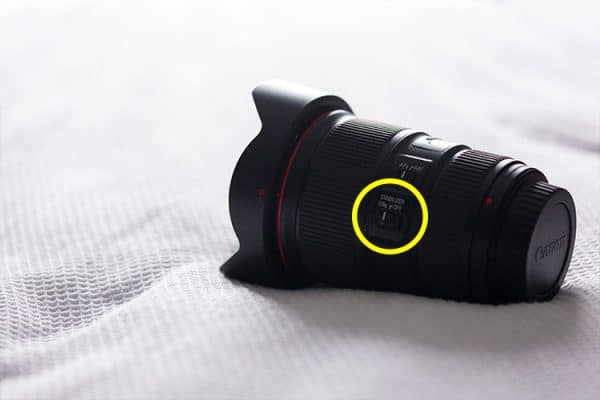
Another item you may find stamped on your lens is image stabilization technology. Each camera manufacturer handles image stabilization slightly differently. Some camera bodies have built in stabilization so the lens doesn’t need to provide stability. Others rely on the lens to provide stabilization. If your camera body does not have it built in, you’ll want to confirm that your lens has image stabilization technology by looking for letters printed on the lens.Unfortunately, the common camera manufacturers abbreviate and market their image stabilization differently. There’s no common set of letters that are used across brands like Canon, Nikon and Sony to indicate image stabilization in the lens. Below are the abbreviations for the common lens brands:
- IS – Image Stabilization (Canon)
- OS – Optical Stabilization (Sigma)
- OSS – Optical SteadyShot (Sony)
- VC – Vibration Compensation (Tamron)
- VR – Vibration Reduction (Nikon)
MACRO
Sometimes you may find the words MACRO printed on the side of a lens. True macro lenses have at least a 1:1 magnification. Often it’s 2:1 or better (see below for more information about Macro lenses and what types of photography they are best for). Lenses created by the popular manufacturers that create at least life-size images on the camera sensor should have MACRO printed somewhere on the lens.
Focusing Motor Type – Sometimes you may also see a series letters (USM, SWM, HSM, etc.) printed somewhere on the lens, or the words “hypersonic” or “ultrasonic.” You’ll especially find this on higher-end or specialty lenses. These are all terms that camera manufacturers use to describe the type of focusing motor in the lens, called a silent wave motor. Sometimes these types of motors are also called hypersonic or ultrasonic. In general, camera manufacturers advertise silent wave motors because they tend to be faster and quieter than the standard focusing motor you’ll find in entry-level lenses.
As with image stabilization, every camera manufacturer advertises and markets their own type of silent wave motor. You’ll see different abbreviations for each of the major brands. Below are the silent wave motor abbreviations for the common lens brands:
- USM (Canon)
- HSM (Sigma)
- SSM (Sony)
- USD (Tamron)
- SWM / AF-S (Nikon)
It’s important to note that the difference in these letters and what words like ‘hypersonic’ means is completely dependent upon the manufacturer. There are no industry standards about silent wave motors in the same way that focal lengths and apertures are standardized among It’s best to read reviews about the lens performance online rather than rely on the motor type alone to describe the quality.
Common Focal Lengths of Lenses & What They Are Used For
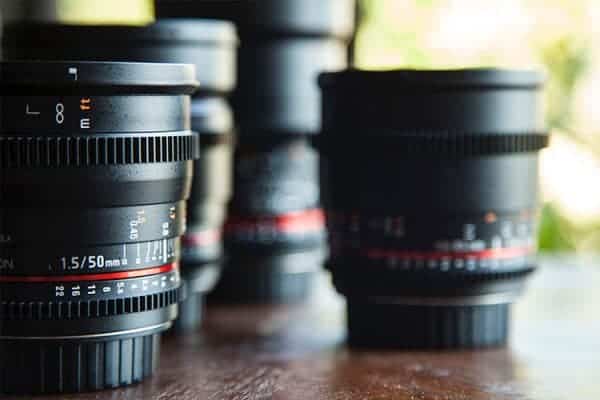
Now that you know how to determine the focal length range of a lens and the maximum aperture of your lens, you can understand the basic performance of almost any camera lens. Lenses come in some common focal length sizes which allow you to compare them apples to apples across different brands. It’s helpful to know the basic lens sizes that are common for beginners to own and what type of conditions they’re most useful for.
Wide Angle Lenses (25 mm or less) – The first type of common lens with some of the shortest focal lengths are wide angle lenses. The industry standard for wide-angle lenses is to cover a focal length 25 mm or less on a crop sensor camera (40 mm or less on full-frame). It gives photographers the ability to capture a short focal length, but a wide field of view.
Wide angle lenses are popular for landscape and architecture photography where it’s important to capture as much background and scope of the scene as possible. In most cases, wide-angle lenses will give a field of view of 65 degrees or more, giving you more control to get close to a subject without losing elements of the background. There’s also a small subset of wide angle lenses known as ultra-wide angle lenses. These have focal length ranges of 10-15 mm and are used to get very close to a subject and still include a background in view.
When purchasing a wide-angle lens, you want to focus on getting as much speed for the most affordable price. Consider choosing a prime wide-angle lens as they have fewer components and tend to be priced cheaper. Prime lenses often times perform better at wide-angle focal lengths anyway as compared to their zoom counterparts.
Standard Lenses (35mm to 60 mm) 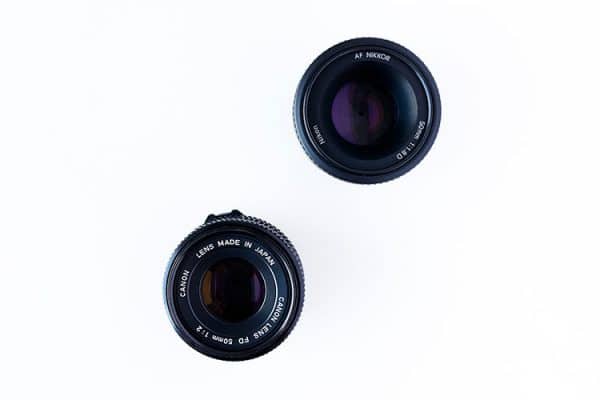 – Lenses that fall between 35 mm and 60 mm focal length are considered ‘standard’ lenses. You may also see them marketed as ‘standard zoom’ or ‘normal’ lenses. Most photographers start with lenses in this focal length range, and they are common as camera kit lenses. Between wide-angle and telephoto lenses, standard lenses are the best at capturing the same scene as the naked eye.
– Lenses that fall between 35 mm and 60 mm focal length are considered ‘standard’ lenses. You may also see them marketed as ‘standard zoom’ or ‘normal’ lenses. Most photographers start with lenses in this focal length range, and they are common as camera kit lenses. Between wide-angle and telephoto lenses, standard lenses are the best at capturing the same scene as the naked eye.
Standard lenses are considered ‘general purpose’ lenses because they can be used for all types of photography. They are common for portraits and large group photos, street photography and any situation where you’re photographing with the flexibility to move around and get the best angle to shoot from.
Beginning photographers sometimes glance over the value of a standard lens, preferring to jump right to the effects of a wide-angle or telephoto lens. Yet the performance of standard lenses should not be overlooked. Photos taken with a standard lens are the most natural and can have higher image quality than those taken with a zoom lens. Prime lenses in standard lengths are small, lightweight, and offer a lot of speed over other lenses.
Telephoto Lenses (70 mm or longer) 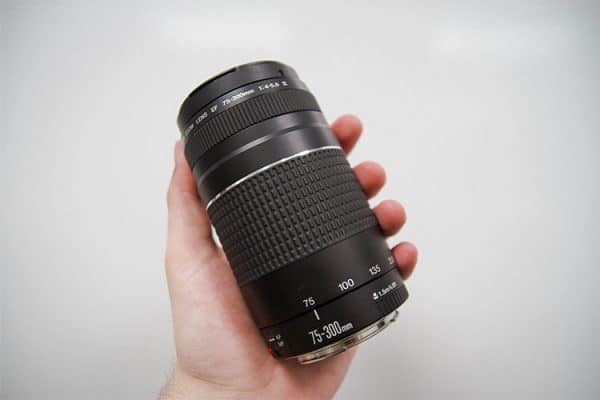 — Lenses that are 70 mm or longer are known as telephoto lenses. Beyond kit lenses, this is often where beginning photographers invest in their first lens. Telephoto lenses are most often zoom lenses, giving you a wide variety of focal lengths to shoot with. Popular ranges include 70-200 mm, 80-400 mm, 70-300 mm. Telephoto lenses compress distance, making subjects look closer than they are to the naked eye.
— Lenses that are 70 mm or longer are known as telephoto lenses. Beyond kit lenses, this is often where beginning photographers invest in their first lens. Telephoto lenses are most often zoom lenses, giving you a wide variety of focal lengths to shoot with. Popular ranges include 70-200 mm, 80-400 mm, 70-300 mm. Telephoto lenses compress distance, making subjects look closer than they are to the naked eye.
Telephoto lenses are popular among sports, wildlife, and nature photography. Telephoto lenses allow you to bring the action of these scenes up close in an image. They are less commonly used in portrait, street, and landscape photography because of the potential for distortion and the loss of background when zooming in close to a subject.
When purchasing telephoto lenses, it’s important to select the most speed for the greatest focal length. Speed is especially important here, as stopping wildlife and sports subjects on the move can be difficult to do without introducing blur and noise to the image. Choosing a lens with an aperture of f/4 or larger is best, even if it’s a significant investment.
Super-telephoto/Ultra-telephoto Zoom Lens (greater than 300mm) — If you plan to spend a majority of your time shooting sports and wildlife photography, you may consider investing in an ultra-telephoto lens. These are a sub-set of telephoto lenses that have focal lengths of at least 300-400 mm. Considered a ‘specialty lens’ ultra-telephoto lenses are high-priced, but allow photographers to clearly focus on subjects far in the distance.
Just like other telephoto lenses, ultra-telephoto lens buyers should shop for the most speed for the greatest focal length. Given how important it is to stop motion in these photos (and the high potential for noise and blur at long distances), it’s often better to choose a slightly shorter focal length if it means you can achieve a higher speed. Budgets for ultra-telephoto lenses vary greatly, but it is possible for a beginner to shop around for an affordable product that will shoot like the pros.
Macro (focal lengths vary)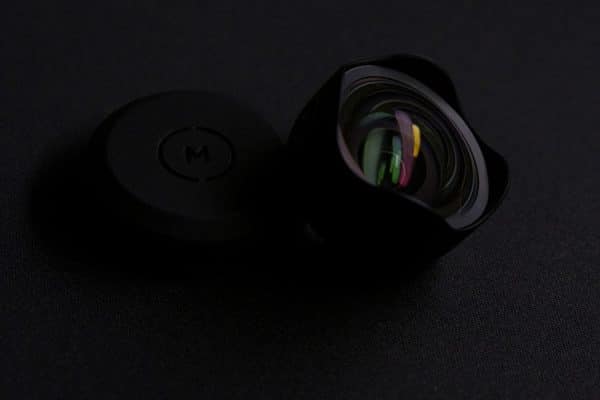 Another common lens to find in a photographer’s bag is a macro lens. They are the perfect lens if you find yourself regularly taking close-up shots like flowers, insects, or detailed food photography.
Another common lens to find in a photographer’s bag is a macro lens. They are the perfect lens if you find yourself regularly taking close-up shots like flowers, insects, or detailed food photography.
Macro lenses come in short lengths (good for low light, macro, and some portraits) as well as standard macro lenses (shooting about 9-11 inches away from the subject in good lighting) and telephoto macro lenses (shooting up to 2 feet away). While the focal lengths vary, macro lenses come with a ‘minimum focus distance’ that will indicate the closest you can be and still have the subject clearly in focus.
One of the biggest distortion concerns with macro lenses is called chromatic aberration. It’s a technical term to describe the ‘halo’ of purple/yellow coloring that occurs on the fringe of subjects in macro photos. With careful composition and some post-processing techniques, it’s possible to correct this, but you’ll want to read performance reviews before purchasing Macro lenses to be sure you’ll be getting the highest quality image possible.
Some entry-level lens kit will attempt to sell that your zoom lens functions as a macro. However macro lenses provide the best magnification and image quality without distortion. look for MACRO printed on your lens for true macro technology.
Related Posts
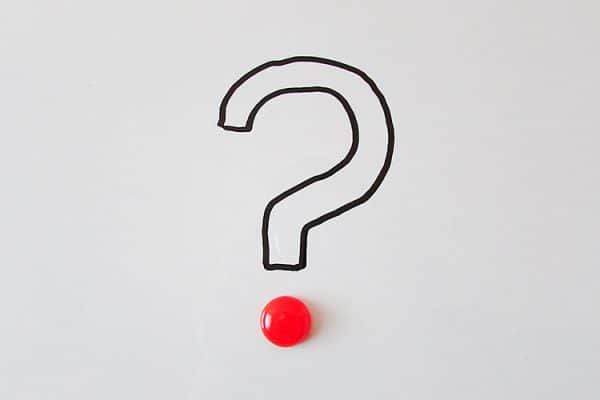
Can you put a Canon lens on a Nikon mount?
While it may be tempting to switch lens brands when you upgrade equipment or when you see a good sale on lenses, there’s no way to interchange a Canon lens with a Nikon lens. The camera kits mount completely different and are not compatible. There are third-party lenses that are compatible with either Canon or Nikon lenses. However, these still are not interchangeable between brands. To date, there is no such thing as a ‘universal’ lens mount.
The same applies to lens filters, remote shutter releases, and external flash. Many of these camera accessories are exclusive to the brand of lens and are not interchangeable. It’s important to review your manufacturer’s guide to determine compatibility with camera accessories.
You may be surprised to know though, that in some cases you may be able to use your old film lenses with a DSLR camera body. Canon has used the same lens mount system since 1987. Nikon’s has been around since 1959. If you have a film lens that dates back around then, you should be able to get it to attach to your camera body.
What are the best camera lenses for beginners?
Before you start shopping for new lenses, you’ll want to know before purchasing a lens is what you plan to use it for. A good multi-purpose lens can elevate all types of photography. However, if you plan to shoot flowers, sports, or wildlife you might be better off choosing a more specific lens. Most photographers start to specialize in lenses that match the types of photography they shoot the most.
A few lenses everyone should consider having in their camera bag: A 50 mm f/1.8 prime lens. It’s a gold standard for portraits and street photography. A versatile zoom lens with a range of at least 70-300 mm is also helpful to have around. It will give a bit more zoom than your standard kit lens and offer higher quality images. Finally, consider a wide-angle lens. It’s great for small quarters and shooting large objects like buildings. They don’t often come in basic lens kits but should be one of the first you consider adding on.
What factors go into the cost of a camera lens?
If you plan to purchase a new camera lens there are some basic lens features that you’ll want to know when you purchase. Understanding these features can help you better understand why two lenses that look similar on the outside might be sold at very different price points. Considering these factors will also help you to make sure you’re comparing apples to apples across different lens brands.
- Focal Length – Focal length and aperture measures can dramatically change the price and functionality of the lens you purchase. As mentioned above focal length is a measure (in mm) of how wide the angle of view is for the lens. It’s usually found in a range on the side of the camera lens. The higher the focal length, the more zoom a lens has. Both Canon and Nikon manufacture lenses in a variety of focal lengths.
- Aperture – Aperture range will change the range of what is in focus in your image. It can also dramatically change the cost of a lens and what type of photography it’s best for. When buying a lens, the lowest aperture possible (the number found after “f” on the lens body) is generally the best.
- Glass Quality – Another factor that goes into the price of a lens is the quality of the glass. Lower quality glass in lenses can distort images and cause issues in difficult lighting conditions. All of the major camera manufacturers continue to elevate the technology used to make camera lens glass, but it’s worth reading the details of each lens to make sure you’re getting the best quality.
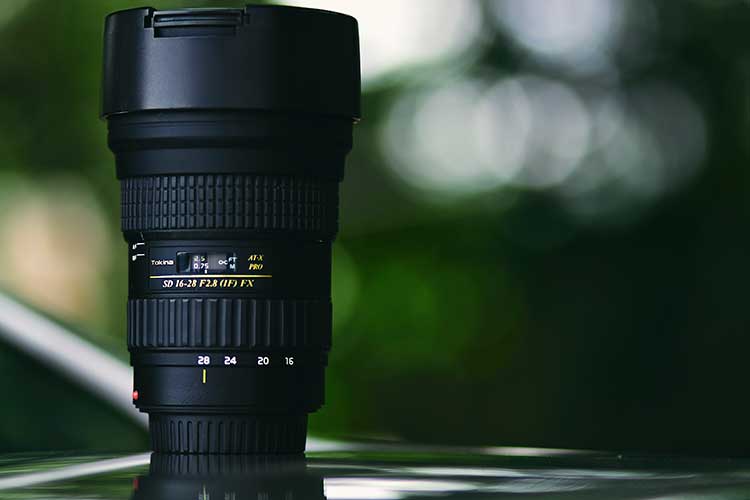
Thanks ..excellent write up.what does the alphabet E , G means after the focal length esp in NIkon lenses f/3.3 E ?
Please explain the difference in distance other than mm? between a 300mm and a 400mm. I have a 300 and photograph wildlife. Thinking about buying a 400mm. Is there a much greater advantage? I am having trouble getting the shots I want with 300mm. I take photos strictly for ref. to paint from. Thank you.
Thank you so much for this article. I am new to photography and still have a lot to learn but your article helped me to understand a lot about the lenses that came with my starter set up from Canon.
A great help to a newbie. Many thanks
I have found a camera lens at an estate sale and was wondering if you could tell me what the numbers on the lens, 4 8/4 front and 4 8/4 back, mean. The lens is made by Gundlach-Manhatten Optical Co. Rochester N.Y. Since I know nothing about camera lens, I would appreciate your help. Thank you
Absolutely the beginner level I was hoping for. thank you.
Thank you for your excellent article, well laid out, clear and concise with no frightening and off putting jargon. My reason for reading was to gain a little knowledge prior to commencing a photography for beginners course and I had a list of about a dozen questions which you answered all but one of them superbly.
The one you failed to mention, but in fairness wasnt pertinent to your article was, “What is meant by noise in a picture?”
Thank you for sharing information on cameras and lenses for beginners in an easy to understand language. Everything is clear except the difference between full frame vs crop sensor cameras.
Thank you for the time that you spent on this write up. THANKS!!